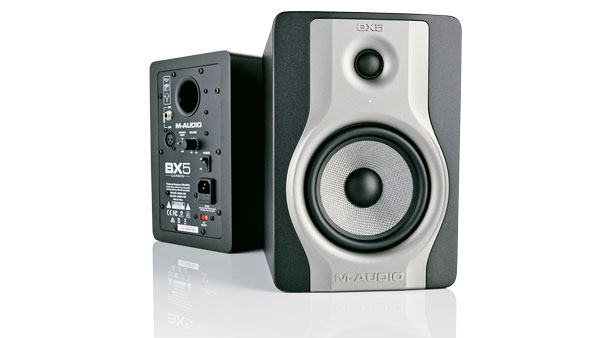MusicRadar Verdict
Compact, solid and surprisingly loud, this is an ideal affordable monitor for smaller spaces.
Pros
- +
Compact. Loud. Bass adjustment for awkward spaces. Good value.
Cons
- -
No HF trim.
MusicRadar's got your back
Since its introduction over a decade ago, the BX5 has been through a number of different incarnations, all the while receiving solid support and always offering incredible VFM.
Its latest update, the BX5 Carbon, continues to tick these very same boxes. It now sports a silver and black front panel with matching woofer cone but, from a specification perspective, it's incredibly similar to its predecessor, the BX5 D2.
"This overall sonic balance is great for working on critical balance elements such as vocals, and also good for balancing reverbs"
The two-way design uses a one-inch silk domed tweeter and five-inch woven Kevlar woofer (both magnetically shielded), with crossover at 3kHz.
Individual (and improved) class AB amplifiers drive the LF and HF units (40W and 30W respectively), and bass extension is improved using a rear ported reflex design. The cabinet is vinyl laminated MDF, and rear panel connections are regular mains, XLR and TRS jack.
Both inputs can be connected at the same time, which, if you're careful with your sends, is a minor but quite useful feature. Level is set using the rear Volume control (alas this has no notching or unity position), and there's also a bass management option called Acoustic Space (more about this shortly).
Finally, there are no controls on the front panel (the power switch is on the back), however there is a discreet blue LED in between the woofer and tweeter so you know you've got power.
Space solutions
The Acoustic Space setting was included on the original BX5 and it's good to see this re-introduced. It includes three settings (Flat, -2dB and -4dB) and helps with bass response when positioning near to walls or in corners.
The manual indicates that ideally they should be placed at least a foot from the rear wall and certainly no nearer than three inches. We found about half a metre from a straight back wall (so not in a corner) worked well with the Flat setting but, as we moved them closer to the wall, the extra bass became more problematic. Here, depending on how bad the problem was, either setting certainly helped even out the response.
So, with the monitors suitably positioned, how do they sound? The first thing to note is the low mids centred around the 300Hz mark are a bit on the light side. This means there's a bit of roundness missing in sounds, and this is particularly noticeable with voices and upper bass harmonics.
However, the low frequency extension is reasonable for a unit this size, so in general terms the BX5 doesn't feel lacking on lower frequencies. Moving on to the mid range and here it does sound quite forward (much like the Yamaha NS10s).
However, unlike an NS10, the high frequencies are much better represented, making for a quite bright sounding monitor. This is where an HF trim would be handy, but alas no dice.
This overall sonic balance is great for working on critical balance elements such as vocals, and also good for balancing reverbs. At lower volumes there's still enough mid-range detail to work successfully. At higher levels, and these monitors go pretty loud considering their size, it can be a tad fatiguing, but that is the nature of many nearfield monitors.
We find each monitor type tends to have its own ideal listening level and, for me, the BX5 Carbon is best at mid to quieter levels. This can make the light low-mid delivery more prominent, so we found we needed to compensate a little in that regard.
Even so, for compact affordable monitors these are pretty good - robust, loud if you need them to be, and plenty of low frequencies without sounding out of control. An HF trim would certainly be on our wish list, as would a notched level control to aid even L/R settings.
However, at £178 a pair, the BX5 Carbon offers incredible value and, with the return of the Acoustic Space option, is now better suited to smaller rooms and awkward spaces.
Jon is a London based platinum award winning mixer, producer, composer and club remixer with a diverse CV that spans dance, pop, rock and music for media. He’s also a long term contributor to MusicRadar's music technology tutorials and reviews. Whether working alone or collaborating he usually handles final mixdowns, so you’ll also find MusicRadar peppered with his handy mixing tips.
With its latest free update, Ableton has finally turned Note into the app I always wanted it to be
Technically capable, but struggle to make your tunes sound musical? 5 simple music theory hacks to make your tracks stand out
"Despite its size, it delivers impressive audio quality and premium functions as well as featuring a good selection of inspired sounds": Roland GO:Piano 88PX review











